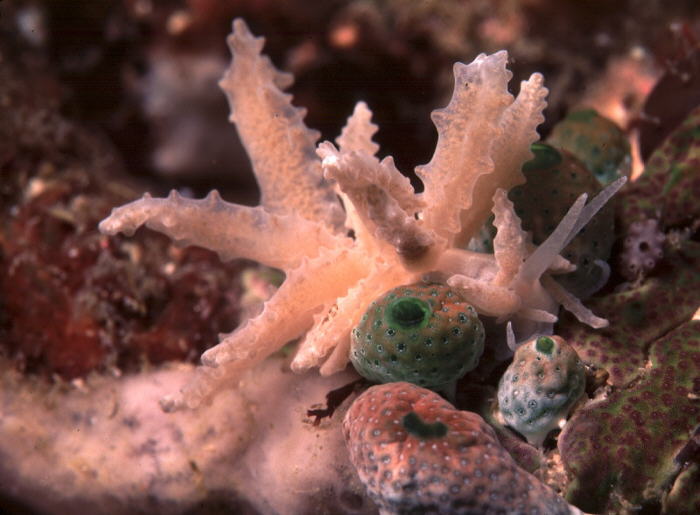 |
Phyllodesmium crypticum
Photo courtesy of Webmaster
Kirby's Rock, Batangas, Philippines May 2000
As its name implies, this small phyllodesmid aeolid is highly cryptic, blending almost invisibly with Xenia, its soft coral prey. It is very difficult to find because it burrows into the fleshy 'trunk' of the colony. Phyllodesmium crypticum is another one of the many species of aeolid nudibranchs that store zooxanthellae in their body tissue. P. crypticum acquire the zooxanthellae from the Xenia, and obtain nourishment when these cells carry out photosynthesis.
Phyllodesmium crypticum is very similar in appearance to Phyllodesmium hyalinum which also feeds on Xenia. When identifying Mike's slide above I went to several references only to get conflicting results. Figure 273 from Nudibranchs of Heron Island shows a species almost identical to Mike's critter here but it is labeled Phyllodesmium hyalinum. I think Bill Rudman's Sea Slug Forum provides the best comparisons of these two species, providing a series of photographs showing the variation in ceratal morphology. The following distinguishing characters between the two species are excerpted from Bill's discussions. The cerata of P. crypticum are very nodulose, especially along the edges, whereas in P. hyalinum the cerata are basically smooth. The cerata are arranged in arches in both species, but in P. hyalinum they are much more numerous and arranged in double rows. Bill adds that the most important difference is the position of the anal papilla. In P. hyalinum it is situated above and slightly behind the second ceratal arch on the right side, while in P. crypticum it is inside the second arch which consists of a single row of cerata. This feature is a little hard to discern from most photos, so in this case we'll just have to wing it. One very good feature that is clearly visible in Mike's photo is that the anterior foot corners in P. crypticum are developed into tentacular processes while in P. hyalinum they form only slightly rounded extensions. This is likely why Marshall and Willan ID'd Figure 273 as P. hyalinum.
Phyllodesmium crypticum is certainly a fascinating little species that has developed protective resemblance to an art. A comparison of the morphology of the cerata with that of the polyps of Xenia is uncanny. It also employs another defensive mechanism, that of autotomizing their cerata when disturbed.
The geographic distribution of Phyllodesmium crypticum is not well documented. Originally described from tropical Australia, Bob Bolland has collected it in Okinawa and we present it here from the Batangas region of the Philippines.
References of interest:
Rudman, W.B. (1981) The anatomy and biology of alcyonarian feeding aeolid
opisthobranch molluscs and their development of symbiosis with
zooxanthellae. Zoological Journal of the Linnean Society 72: 219-262.
Rudman, W.B. (1991) Further studies on the taxonomy and biology of the
octocoral-feeding genus Phyllodesmium Ehrenberg, 1831 (Nudibranchia:
Aeolidoidea). Journal of Molluscan Studies, 57(2): 167-203.
Danville, Calif
April 2001
Taxonomic information courtesy of Dave Behrens

David W. Behrens
Author:
Pacific Coast Nudibranchs
Send Dave mail at seachalleng@earthlink.net
|
